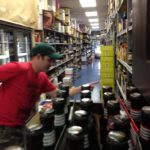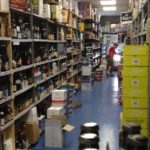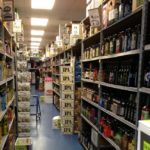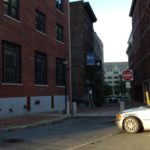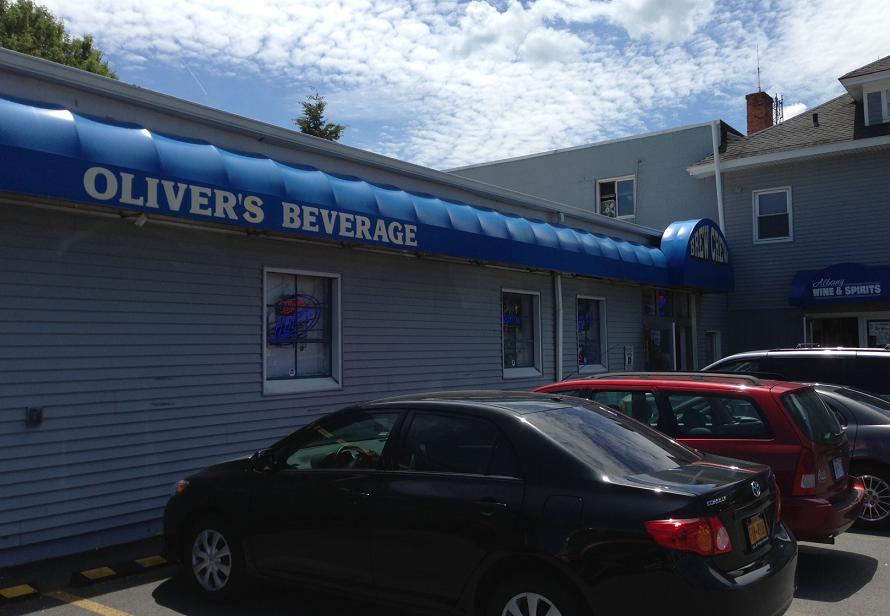 So, did you know I went to Albany, New York last week? It was a five hour drive down last Tuesday and another five back the next day. I enjoy the drive inordinately as it is a drive back in time south through lands settled in the early 1800s, along following the Erie Canal finished in the 1820, past pre-contact Mohawk communities, past the noses and down into the Hudson Valley first settled by the Dutch in the 1610s. And there is a great beer store. Which sorta covers two of my interests fairly well. The beer store is Oliver’s Beverages, nicknamed the Brew Crew, associated with but legally distinct from Albany Wines and Spirits presumably due to the state’s liquor laws. It’s all there in the photo above.
So, did you know I went to Albany, New York last week? It was a five hour drive down last Tuesday and another five back the next day. I enjoy the drive inordinately as it is a drive back in time south through lands settled in the early 1800s, along following the Erie Canal finished in the 1820, past pre-contact Mohawk communities, past the noses and down into the Hudson Valley first settled by the Dutch in the 1610s. And there is a great beer store. Which sorta covers two of my interests fairly well. The beer store is Oliver’s Beverages, nicknamed the Brew Crew, associated with but legally distinct from Albany Wines and Spirits presumably due to the state’s liquor laws. It’s all there in the photo above.
Craig, as master of ceremonies for the trip, took me there on Tuesday night and I went back to buy a mixed box to take home on my way out of town. This is a point to be understood clearly. It is amazingly handy for the traveling beer nerd. You pass the place if you are driving from Boston to any points west of Albany. You pass the place if you are driving from Quebec or any part west of it in Canada to New York City… or Boston. It sits near where Interstate 87meets Interstate 90 and is only, as we say, one jig and one jog from exit 5. Handy does not explain how handy this place is for the motoring beer nerd.
Second… and appreciate this coming from me… I think this is the best beer store I have ever seen. Let me explain “best”… it is massive. 1500 types of beer. I did not count. I was told. But the selection is mind boggling. And I mean this as someone whose mind in fact boggled. If you click on the two thumbnails above to the left, you will see Craig illustrating the scale of the place by first pointing to a bottle near the camera. And then running to the far end of the aisle and pointing at one there. I have a rule about US beer stores. I touch no bottle for five minutes as the whole boggling thing is to be expected. Twice this year I have read the phrase “well curated” in relation to a beer selection offered at an establishment. Screw that. I want it all. I did notice an absence of Girardin but there wasn’t much else I would miss.
The prices were also quite fair. Dupont Bon Voeux was $11.59 before the 10% mixed case discount. Ale Smith Nut Brown was $6.49. And, while it is not curated, there is curator. If you click on the thumbnail to the centre-right you will see Nico, the craft beer selection manager down at the end of another aisle. Nico, as he kept loading shelves, had all the time to chat with Craig and me on both visits, was very knowledgeable about beer nerd culture as well as his stock. I asked him about the effect of the scale of the selection and we discussed how the store was organized in such a matter that it helped the buyer cope with that. Styles and breweries are gathered within an overall geographical location, There are also shelves and shelves of ciders and perries and such.
It is in a way an artefact of this point in time. The physical space, the need to organize, the warehouse style shelving, the data all around you on signs, cards, stickers, labels and bottles. I am increasingly aware of how I am informed by space. If you look at the thumbnail to the far right up above you will see another example. It’s taken on Beaver Street just by the intersection of Green. The corner is the site of the mid-1700s King’s Arms, the 1776 flashpoint of the American Revolution in the Albany area and the founding business of the Cartwright clan of Loyalist Tories that were key to the establishment of my city of Kingston Ontario and in fact, the entire province and indeed the nation of British North Americans. But that, oddly, is not my point in posting that picture. Do you see how the street distinctly turns to the left? That turn expresses something a hundred years older than the King’s Arms, the southern design of the palisades of the original settlement. You can see it in this map from 1770 but, more particularly, you can see it in the 1695 map Craig posted to describe the community in the 1600s Dutch era. The intersection of Beaver and Green is located to the left, mid-way up. Beaver Street arcs in parallel to the settlement’s wall.
Which is interesting. Which reminds me that you can see things even when they are no longer there or, even, see things implicit in a space. Like the wall of the palisade that hasn’t been there for the best part of 300 years. Or the sound of that tavern brawl two hundred and thirty-seven which, in part, led to the creation of two countries. Or the state of good beer culture from the scale of a store.

